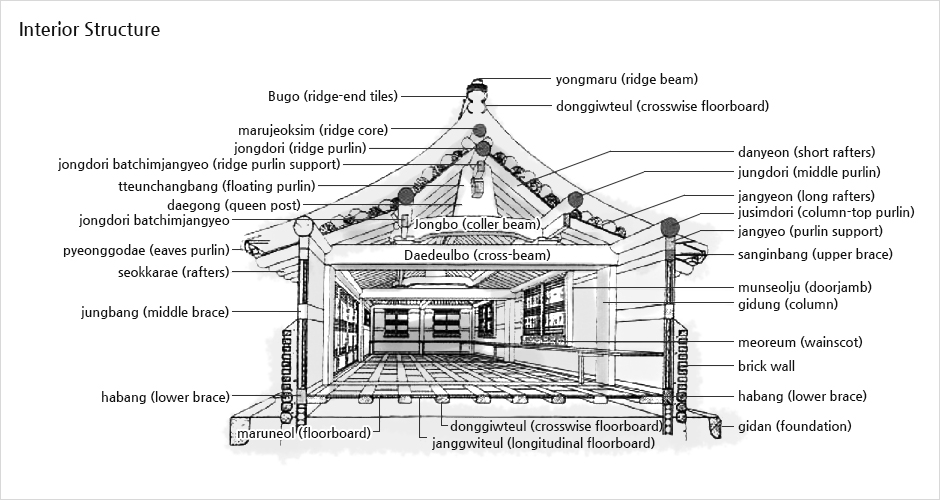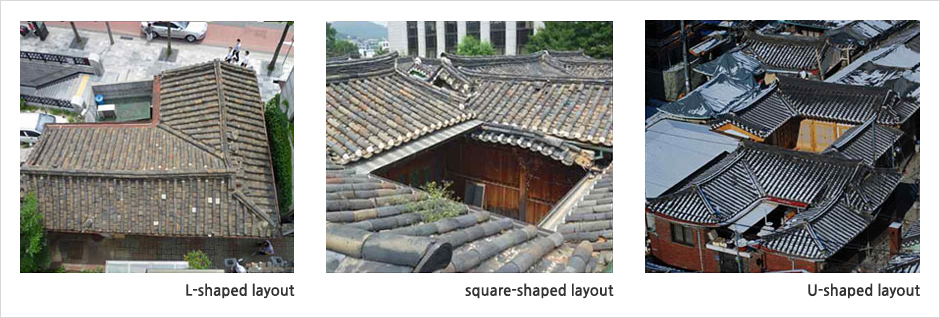이용불편 신고가 완료되었습니다.
Hanok Data
Hanok Data
Basic Hanok Data
Structure of Hanok
Basic Structure of Hanok
 Structure of Hanok (Source: Easy-to-follow Guide for Building and Repairing of Hanok)
Structure of Hanok (Source: Easy-to-follow Guide for Building and Repairing of Hanok)
The structure of the Korean traditional house called a hanok consists of a wooden framework consisting of columns, crossbeams, purlins, rafters and various types of supports and connectors. Generally speaking, the elements of the framework varied depending on the region, the owner’s social status and the purpose of each house. Houses in the north of Korea, for instance, tended to feature a double-house layout with a low ceiling, which was effective in maintaining interior warmth against the cold external air during the winter season, while those in the south featured a single-line layout designed for effective air circulation, and a raised, wood-floored main hall (maru) at the center. The houses of wealthy upper-class families often consisted of multiple buildings arranged to reflect their social status, with the men’s living quarters separated from those of the female members of the family, and those for senior members separated from those of the junior members, by low walls. For the great majority of ordinary families, however, function was more important than aesthetic elements not only in the layout but in the use of materials as well. (See Jeon Bong-hui, “History and Future of Hanok” in Our Home Is Hanok [Urijibeun Hanogida], National Trust, 2007, 19-24.)
Architectural Layout of Hanok
Traditional Korean houses can be divided into several types according to their layout, i.e. U-shaped, L-shaped, square and straight-lined. The U-shaped layout is characterized by the location of the wood-floored main hall (maru) and the kitchen in the central portion of the building, with the bedrooms situated in the wings, thus creating symmetry and balance. Such houses also tended to feature a gabled or hip-and-gable roof.
(See Yoon Chang-sup, Hanguk Geonchuksa [History of Korean Architecture], Dongmyeongsa, 1975, 41-43.)
The square layout was usually preferred in the north of Korea where the winter is longer and harsher than in the south, because it was believed to be more effective in maintaining the warmth of the interior. Houses built according to this layout tended to have a wider inner space than U-shaped or L-shaped houses of the same size because all their rooms were connected with each other. The wood-floored main hall (maru) was typically located at the center of the house, thus providing direct access to the other rooms, including the kitchen.
(See Yoon Chang-sup, 51-55.)
The L-shaped house is characterized by a simple appearance created by connecting two straight-lined houses at a right angle. This layout was preferred by families who wanted a larger yard, even if that meant having a smaller interior compared with the square house. The wood-floored main hall (maru) typically connects with the kitchen at the point where the house is angled, thus ensuring greater spatial efficiency and functionality.
(See Yoon Chang-sup, 64-68.)
As for houses with a straight-lined layout, the interior tended to be more compact than that of other layouts and to have more windowed doors in order to receive more natural light. The type of house also differs from the others in that, as it is typically open to all four directions and hence receives more sunlight, it offers a wider range of options when deciding which direction to face.
(See Yoon Chang-sup, 69-73.)
(See Yoon Chang-sup, Hanguk Geonchuksa [History of Korean Architecture], Dongmyeongsa, 1975, 41-43.)
The square layout was usually preferred in the north of Korea where the winter is longer and harsher than in the south, because it was believed to be more effective in maintaining the warmth of the interior. Houses built according to this layout tended to have a wider inner space than U-shaped or L-shaped houses of the same size because all their rooms were connected with each other. The wood-floored main hall (maru) was typically located at the center of the house, thus providing direct access to the other rooms, including the kitchen.
(See Yoon Chang-sup, 51-55.)
The L-shaped house is characterized by a simple appearance created by connecting two straight-lined houses at a right angle. This layout was preferred by families who wanted a larger yard, even if that meant having a smaller interior compared with the square house. The wood-floored main hall (maru) typically connects with the kitchen at the point where the house is angled, thus ensuring greater spatial efficiency and functionality.
(See Yoon Chang-sup, 64-68.)
As for houses with a straight-lined layout, the interior tended to be more compact than that of other layouts and to have more windowed doors in order to receive more natural light. The type of house also differs from the others in that, as it is typically open to all four directions and hence receives more sunlight, it offers a wider range of options when deciding which direction to face.
(See Yoon Chang-sup, 69-73.)
 Framework of Hanok (Source: Easy-to-follow Guide for the Building and Repairing of Hanok)
Framework of Hanok (Source: Easy-to-follow Guide for the Building and Repairing of Hanok)
The hanok, while it maintains traditional architectural elements, is flexible enough to meet a variety of needs created by the dwellers and their environments, and continues to develop according to changes in the lifestyles of Korean people. Recently, there appeared a new term, sinhanok (“new Korean traditional house”), which is used to refer to hanok designed to be better adapted to the modern lifestyle, with the support of the relevant government policy. These new hanok are designed to maintain the traditional wooden framework and appearance that Korean people are so fond of, but have a more complex and functional interior created by using modern materials, systems and techniques. Interpretations vary as to the distinctive features of the new hanok.
A number of new concepts, terms and designs have been developed to better adapt the new hanok houses to modern life. The term, literally meaning “Korean house”, first appeared in reference to the houses built and dwelled in before the arrival of Western-style houses which were, in turn, called yangok, or “western houses”. There is no agreed definition for hanok, and ideas continue to evolve as more and more Korean people become interested in the preservation and transmission of this wonderful architectural heritage and the related culture.
※ References
Jeon Bong-hee & Lee Kang-min, “Definition and Scope of Hanok,” Hanok Policy BRIEF, no. 2 (Architecture & Urban Research Institute in Auri National Hanok Center, November 2011)
A number of new concepts, terms and designs have been developed to better adapt the new hanok houses to modern life. The term, literally meaning “Korean house”, first appeared in reference to the houses built and dwelled in before the arrival of Western-style houses which were, in turn, called yangok, or “western houses”. There is no agreed definition for hanok, and ideas continue to evolve as more and more Korean people become interested in the preservation and transmission of this wonderful architectural heritage and the related culture.
※ References
Jeon Bong-hee & Lee Kang-min, “Definition and Scope of Hanok,” Hanok Policy BRIEF, no. 2 (Architecture & Urban Research Institute in Auri National Hanok Center, November 2011)





